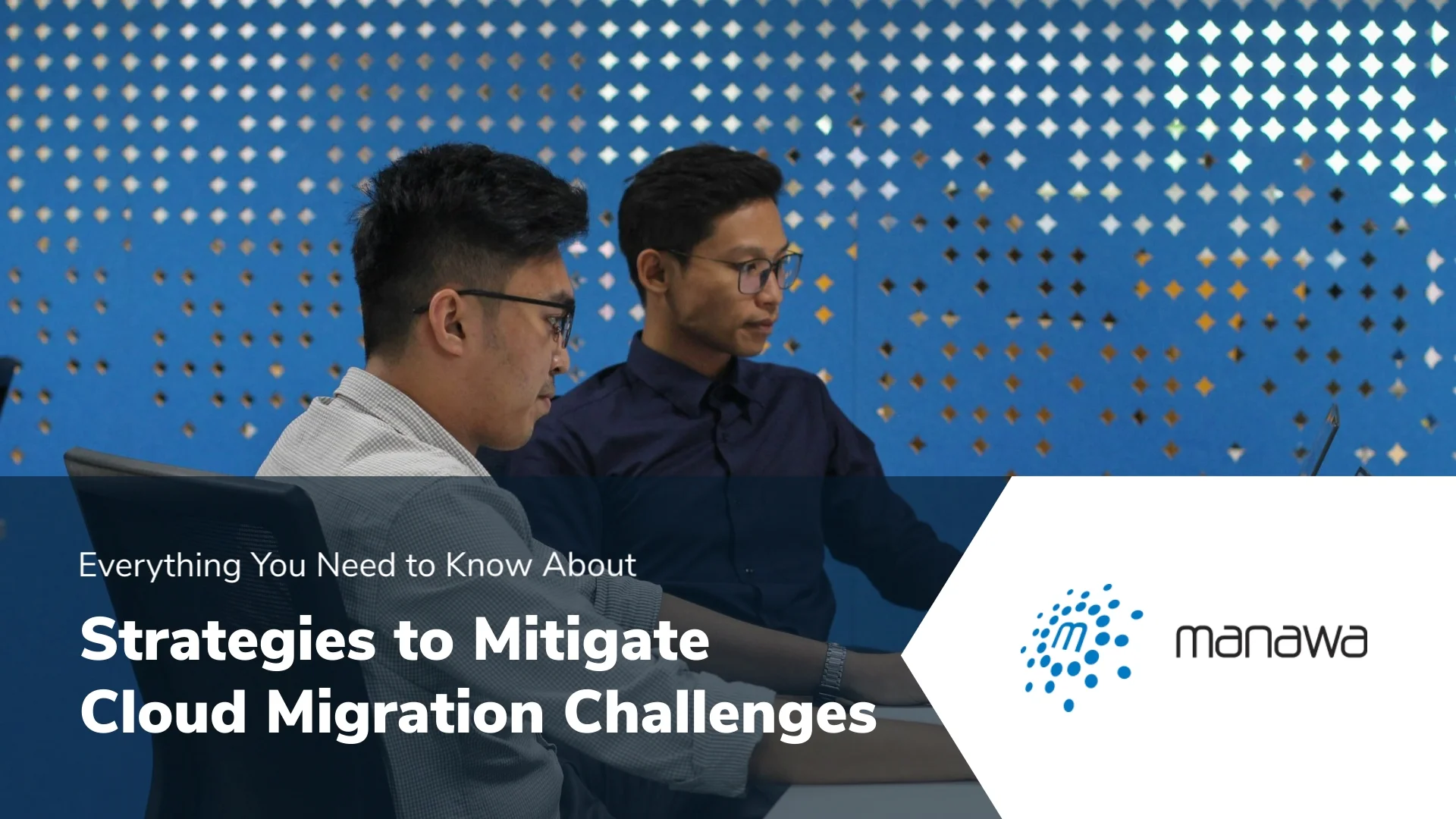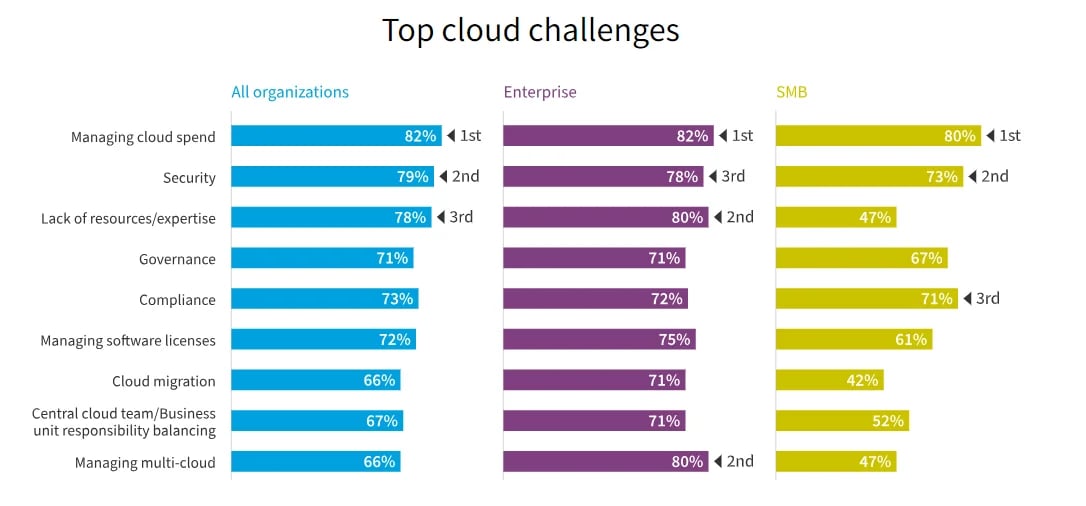The Best Methods for Mitigating Cloud Migration Challenges

The journey to the cloud is more than a mere technological shift; it's a pivotal move toward operational excellence and innovation.
This shift promises flexibility, scalability, and cost savings.
However, this journey is accompanied by challenges that businesses must navigate wisely. Flexera’s 2023 State of the Cloud Report shows that the top cloud migration challenges are security, spend and expertise.
Understanding these challenges and employing effective strategies to mitigate them is crucial for a successful transition.
|
As Matthew Held, CEO at Manawa Networks, says, “Without a solid cloud migration strategy, navigating the transition is like finding your way out of a maze without a map." |
This blog explores the hurdles of cloud migration and provides strategies for overcoming them.
Understanding Cloud Migration Challenges
1. Cost Management
Although moving to the cloud has the potential for cost savings, managing these costs can be challenging. Unexpected expenses often arise from inefficient resource use, such as over-provisioning or failing to optimize pricing models offered by cloud providers. As per Flexera’s State of Cloud Report 2023, for the first time in a decade, managing cloud spend (82%) surpasses security (79%) to become the number one challenge.
Effective cost management requires continuous monitoring and optimization to ensure that cloud investments deliver the expected return.

Source: Flexera State of Cloud Report 2023
2. Data Security and Compliance
Moving sensitive data to cloud environments introduces significant concerns regarding data security and regulatory compliance. As data breaches can have devastating effects on a company's reputation and finances, ensuring that cloud solutions adhere to stringent security standards is paramount.
Furthermore, different industries are subject to various regulatory requirements, such as GDPR in Europe and HIPAA in the healthcare sector in the United States. Businesses must ensure their chosen cloud platform complies with these laws to avoid hefty fines and legal complications.
3. Skill Gap
Cloud technologies are evolving rapidly, and lacking in-house expertise can severely hinder a successful migration.
This skill gap makes it challenging for organizations to manage and optimize their cloud infrastructure effectively. It can lead to misconfigurations, security vulnerabilities, and inefficient use of resources. Bridging this gap is essential for organizations to fully utilize cloud capabilities.
Experiencing Cost Overruns with Cloud Migration?Manawa Networks delivers cost-effective cloud solutions tailored to your budget. |
4. Legacy Systems and Compatibility Issues
Legacy systems often form the backbone of an organization's IT infrastructure, but they may not be compatible with modern cloud-based platforms.
This incompatibility can lead to substantial challenges in migrating applications and data to the cloud, including disrupted workflows, lost data, and functionality issues. Migrating from these outdated systems requires a thoughtful approach to ensure business operations continue smoothly during and after the transition.
3. Downtime and Data Loss
The risk of downtime and data loss during the cloud migration process is a significant concern for businesses. Up to 94% of companies that experience a severe data loss never recover. Operations can be severely impacted, leading to lost revenue and reduced customer trust.
The complexity of moving large volumes of data and applications without interrupting business operations necessitates meticulous planning and execution. Without it, companies risk extended downtime and potential data loss, which can have long-term effects on business continuity.
Strategies for Mitigating Cloud Migration Challenges
1. Develop a Comprehensive Cloud Migration Strategy
A successful cloud migration starts with a well-thought-out strategy. This involves conducting a thorough assessment to determine which applications and data will benefit most from moving to the cloud, selecting the appropriate cloud platform, and planning the migration to minimize disruption. A detailed roadmap can help manage risks and ensure a smooth transition.
2. Ensure Data Security and Compliance
Choosing cloud solutions that offer robust security features and compliance with relevant regulations is crucial. Implementing comprehensive data protection measures, including encryption in transit and at rest, can safeguard sensitive information. Additionally, businesses should regularly review their cloud security posture to adapt to emerging threats.
3. Manage Legacy Systems
Addressing compatibility issues requires either modernizing legacy applications to work in cloud environments or replacing them with cloud-native solutions. Cloud integration tools can facilitate this transition, ensuring that systems communicate effectively and operations run smoothly.
4. Plan for Downtime
Minimizing downtime involves carefully scheduling the migration process during periods of low activity and employing data migration tools to maintain data integrity. This proactive approach helps ensure that business operations are not unduly affected.
|
More resources you might like: |
5. Bridge the Skill Gap
Investing in training programs for existing staff or partnering with cloud service providers can fill the expertise gap. Cloud service providers bring valuable experience in managing complex cloud environments, enabling businesses to leverage the full potential of their cloud infrastructure.
6. Monitor and Control Costs
Utilizing cloud management tools to monitor spending and adopting cost-saving strategies, such as using reserved instances or scaling resources according to demand, can significantly reduce expenses. Regular reviews of cloud usage and costs can help identify optimization opportunities.
Comparison of Cloud Service Models: SaaS, PaaS, IaaS
Here is a concise comparison of common cloud service models, which can help your business understand their options and considerations during cloud migration.
This comparison can guide you in selecting the most suitable cloud service model based on their needs and challenges.
|
Feature |
Software as a Service (SaaS) |
Platform as a Service (PaaS) |
Infrastructure as a Service (IaaS) |
|
Definition |
Software applications delivered over the internet. |
Platform for developing, running, and managing applications without the complexity of building and maintaining the infrastructure. |
Virtualized computing resources over the internet. |
|
Primary Users |
End-users and businesses looking for ready-to-use applications. |
Developers and businesses focusing on application development without managing infrastructure. |
Businesses that want control over their infrastructure with scalability and flexibility. |
|
Examples |
Google Workspace, Salesforce, Dropbox. |
Heroku, Google App Engine, Microsoft Azure. |
Amazon Web Services (AWS), Microsoft Azure, Google Cloud Platform (GCP). |
|
Management Responsibility |
Provider manages everything. |
Provider manages infrastructure and platforms. Users manage applications. |
Provider manages physical infrastructure. Users manage virtual resources. |
|
Customization |
Limited to the application features provided. |
Allows for application-level customization. |
High level of customization at the infrastructure level. |
|
Scalability |
Easy to scale with provider assistance. |
Scalable; dependent on the provider's platform capabilities. |
Highly scalable; users can adjust resources as needed. |
|
Use Cases |
Email, CRM, collaboration tools. |
Application development, testing, and deployment. |
Web hosting, data storage, big data analysis. |
|
Security Responsibility |
Primarily the provider, though users must ensure secure use. |
Shared; the provider secures the platform, while users secure their applications. |
Primarily the user, with the provider securing the infrastructure. |
Say Goodbye to Cloud Migration Challenges With Manawa Networks

The move to the cloud, while beneficial, comes with its own set of challenges, from data security and compliance to compatibility issues and cost management. However, with careful planning and the right strategies, businesses can overcome these obstacles and achieve a successful cloud migration.
|
Discover Trusted Cloud Service Providers Near You: |
Manawa Networks can help you with these strategies, offering expertise and solutions to navigate the complexities of cloud migration.
Reach out to us for a free consultation and take the first step towards a seamless and secure cloud transition.



